
News
Ancillary revenue reports world airlines grew in 2011
July 23, 2012, Wis. – IdeaWorksCompany, the foremost consultancy in the area of airline ancillary revenues, and Amadeus, a leading travel technology partner and transaction processor for the global travel and tourism industry, today announced the results of the Amadeus Review of Ancillary Revenue Results for 2011.
July 23, 2012 By Wings Magazine
July 23, 2012, Wis. – IdeaWorksCompany, the foremost consultancy in the area of airline ancillary revenues, and Amadeus, a leading travel technology partner and transaction processor for the global travel and tourism industry, today announced the results of the Amadeus Review of Ancillary Revenue Results for 2011.
The IdeaWorksCompany researched the financial filings made by 108 airlines all over the world, 50 of which disclose ancillary revenue activity, to identify that the ancillary revenue reported by airlines grew to €18.23 billion in 2011. This represents ancillary revenue growth of 66 per cent in two years from the 2009 result of €10.95 billion.
Once largely limited to low fare airlines, ancillary revenue is now a priority for many airlines worldwide, and the Review shows how far the industry’s approach to ancillary revenue has developed in recent years.

|
“We’ve seen the industry move swiftly to grasp some clear opportunities for providing ancillary services, such as baggage fees, extra legroom and on-board catering. The next wave of innovation in ancillary services will come from those airlines which develop new products that support their brand positioning and deliver value to the traveler by meeting their individual needs and preferences,” said Holger Taubmann, Senior VP, Distribution at Amadeus. “A multi-channel approach to the distribution of ancillary services is key to realizing this. Amadeus is working with the 46 airlines that have signed up for Amadeus Ancillary Services Solution to deliver an offer that will tailor the travel experience and provide new revenue sources, now and in the future.”
“Our first report into ancillary revenue was issued in 2007, when only 23 airlines worldwide disclosed ancillary revenue activity in financial filings, and the result was a modest €1.72 billion ($2.45 billion). Four years later, 50 airlines today disclose ancillary revenue activity of €18.23 billion ($22.6 billion). It’s clear that airlines recognize the importance of ancillary revenue and are developing increasingly innovative ways to generate this,” said Jay Sorensen, President of IdeaWorksCompany.
ANCILLARY REVENUE: RESULTS BREAKDOWN
Big companies generate big results, and the current analysis confirms the largest ancillary revenue results are delivered by large airlines. The top 10 “Total Ancillary Revenue” list (see Table 1) is dominated by major brands in the global network and low fare categories. American and Delta attain their status through a blend of activities which notably features checked baggage and the sale of frequent flier miles to bank partners. Qantas and TAM are unique because frequent flier program revenue is the primary reason for placement in the top 10. IdeaWorksCompany adds a “Primary Source” column to this year’s tables to identify each carrier’s primary ancillary revenue methods. “Various” describes a range of activities, while “FFP” indicates more than 75 per cent of disclosed ancillary revenue relies upon partner revenue generated from a frequent flier program. Tables expressed in US dollars are provided at the end of this press release.
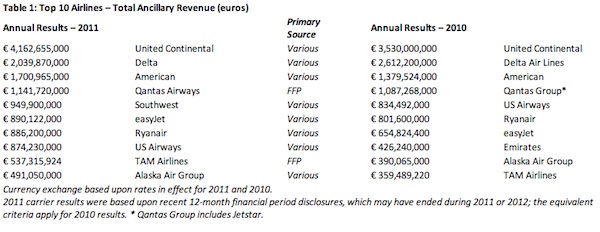
|
As a group, these 10 airlines delivered revenue in excess of €13.7billion, or 75 per cent of the total amount disclosed by airlines for 2011. Airlines generally moved up the chart for 2011 in terms of overall ancillary revenue produced. easyJet passed Ryanair for the first time. Delta's ancillary revenue results decreased during 2011 for a combination of reasons. The airline refined how it discloses ancillary revenue results, now excluding revenue from some aviation-related businesses. IdeaWorksCompany also believes the large advance payment received from American Express during 2010 boosted the cash amount registered that year.
Southwest is a new member of the top 10 list for total ancillary revenue, although the carrier has steadily and gradually moved up the rankings since it first appeared on the 2009 list. While Southwest has chosen not to generate revenue from checked baggage fees, it has embraced the sale of convenience-adding services.
Revenues produced by Southwest’s EarlyBird service, which provides early boarding for a $10 fee, were $142 million (€114 million) during 2011. The Business Select product is designed to attract commercial travelers and provides a package of benefits such as priority airport screening, early boarding, and a welcome cocktail. Ancillary revenue from this initiative was $96 million (€77 million) for 2011. The most effective means by which Southwest has generated ancillary revenue has been its revamped Rapid Rewards frequent flier program. Management has expressed satisfaction over the $250 million (€201 million) revenue bump from improved co-branded credit card results realized during 2011.
Low fare airlines dominate the “% of Total Revenue” top 10 list (see Table 2), as ancillary revenue is naturally a larger piece of the revenue pie for a lower-fare carrier such as easyJet or Tiger Airways. Spirit Airlines rose to the top of this list for 2011.The carrier broke the elusive 30 per cent barrier with a very solid 33.2 per cent.
Consumers choosing a low fare airline can pay a small fare for basic transportation, or opt for everything on the a la carte menu and pay a price comparable to those charged by a global network competitor such as American Airlines or British Airways. Some even promote a €1 fee to have a flight itinerary sent to a mobile phone. With 15 to 33 per cent of revenue produced through these methods, ancillary revenue success is a matter of financial survival for these low fare airlines.
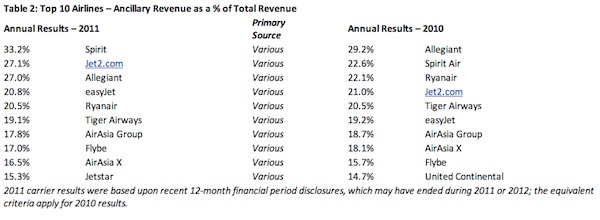
|
The only global giant on last year’s list ‒ United Airlines ‒ was edged off by the addition of Jetstar. The Qantas Group provided sufficient disclosures in its annual report to allow the inclusion of value-based Jetstar in this year’s analysis. The 16.5 million passenger airline generates ancillary revenue from a variety of sources. Jetstar uses the traditional a la carte approach by charging for onboard dining and entertainment, checked bags, and extra legroom seats. It has also learned from the success of its parent by offering a co-branded MasterCard that provides cardholders a choice of Qantas Frequent Flyer Points or Jetstar Dollars redeemable for Jetstar flight vouchers.
The “Per Passenger” top 10 list (see Table 3) provides an interesting mix of global giants, low fare airlines, regional carriers, and traditional network airlines.
The Qantas Frequent Flyer Program generates an amazing amount of revenue on a per passenger basis, notably from the power of its Australian network of co-branded credit cards. The airline takes the novel approach of maintaining multiple bank relationships, unlike the usual method of selecting one bank per consumer market. The program achieved revenue of AUD 1.148 billion (€896 million) during fiscal year 2011. With 8 million members, that’s AUD 143.50 (€112) per member.
The airline also generates a fair amount of revenue from traditional a la carte activities. The Qantas Club collection of airport lounges posted AUD 84 million (€66 million) and retail / advertising activities contributed AUD 54 million (€42 million) during fiscal year 2011. Qantas results for 2011 exclude Jetstar, which was included under the Qantas Group results listed for 2010.
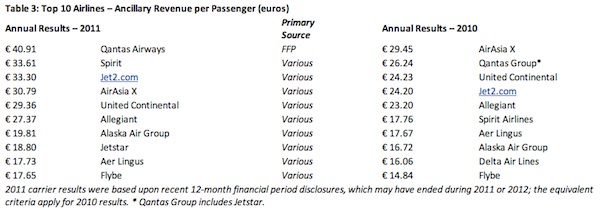
|
Airlines have become more active retailers of travel. Jet2.com, a holiday-oriented airline based in the United Kingdom, and Allegiant Airlines in the U.S., reside in the top 10 list largely based upon their ability to sell vacation packages. Allegiant has dubbed itself as a travel company that happens to own an airline. This list proves there are many ways to reach the top, and the results described in this report are indicative of the evolution that is occurring in how travel is sold to consumers.
IdeaWorksCompany believes the results described in this press release portray the evolution that is occurring in how travel is sold to consumers. The gold rush mentality of “grab every buck, quid, or kopek while you can” from consumers is becoming a relic of the past. It’s a shortsighted view that invites the scrutiny of regulators and the eventual exit of consumers. Successful companies serve their customers successfully, and that’s a lesson learned by every airline executive.
Tables 1a and 3a – US Dollars
The following tables reflect actual dollar disclosures by U.S.-based airlines. All other financial disclosures have been converted to U.S. dollars using rates in effect for 2011 and 2010. Carrier rankings remain the same as euro-based tables but year over year changes for individual carriers will be different due to exchange rate fluctuations.
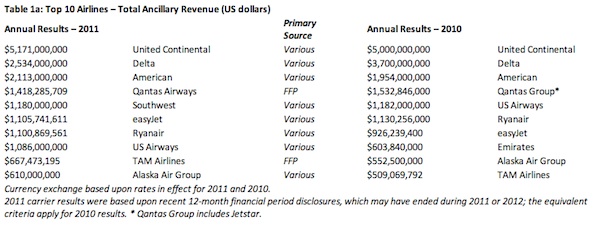
|
|
|
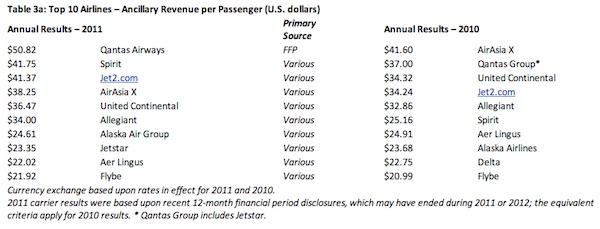 |
|
|
Innovative ancillary services identified by this review:
Airlines are increasingly innovative in their approach to ancillary revenue. During the course of its global review of ancillary revenue activities, IdeaWorksCompany uncovered some unique services. For example:
- KLM allows passengers to pre-order upgraded meals on intercontinental flights from Amsterdam. Economy class passengers can opt for one of five selections, such as the Bella Italia meal for €12 to €15 extra.
- AirAsia rolled out a Red Carpet Service offering elite-style perks from a low-fare airline. Starting at MYR 80 (€21), passengers can enjoy fast-track security, lounge access, early boarding, and a ride to the plane in an electric cart.
- Vueling will hold the middle seat empty, board you early, and provide a drink and snack for €60.
- Qantas sells its Q Bag Tag for AUD 49.95 (€39) as a permanent baggage tag with wireless RFID technology that links to a traveler’s booking and permits easy self-checking of bags on flights within Australia.
- United offers a MileagePlus Explorer Visa card providing a free checked bag, two annual airport lounge passes, early boarding, bonus miles and more for a $95 annual fee the second year.